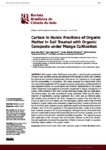Use este identificador para citar ou linkar para este item:
http://www.alice.cnptia.embrapa.br/alice/handle/doc/1048504| Título: | Carbon in humic fractions of organic matter in soil treated with organic composts under mango cultivation. |
| Autoria: | SILVA, J. R.  SILVA, D. J.   GAVA, C. A. T.   OLIVEIRA, T. C. T. de   FREITAS, M. do S. C. de   |
| Afiliação: | JOYCE REIS SILVA, UNIVERSIDADE FEDERAL RURAL DO SEMIÁRIDO DAVI JOSE SILVA, CPATSA CARLOS ALBERTO TUAO GAVA, CPATSA THAISI CAROLINE TAVARES DE OLIVEIRA, UNIVERSIDADE ESTADUAL DO SUDOESTE DA BAHIA MARIA DO SOCORRO CONCEIÇÃO DE FREITAS, INSTITUTO FEDERAL DE EDUCAÇÃO CIÊNCIA E TECNOLOGIA DO SERTÃO PERNAMBUCANO. |
| Ano de publicação: | 2016 |
| Referência: | Revista Brasileira de Ciência do Solo, v. 40, p. 1-11, 2016. |
| Conteúdo: | Soil organic matter (SOM) plays a key role in maintaining the productivity of tropical soils, providing energy and substrate for the biological activity and modifying the physical and chemical characteristics that ensure the maintenance of soil quality and the sustainability of ecosystems. This study assessed the medium-term effect (six years) of the application of five organic composts, produced by combining different agro-industrial residues, on accumulation and chemical characteristics of soil organic matter. Treatments were applied in a long-term experiment of organic management of mango (OMM) initiated in 2005 with a randomized block design with four replications. Two external areas, one with conventional mango cultivation (CMM) and the other a fragment of regenerating Caatinga vegetation (RCF), were used as reference areas. Soil samples were collected in the three management systems from the 0.00-0.05, 0.05-0.10, and 0.10-0.20 m layers, and the total organic carbon content and chemical fractions of organic matter were evaluated by determining the C contents of humin and humic and fulvic acids. Organic compost application significantly increased the contents of total C and C in humic substances in the experimental plots, mainly in the surface layer. However, compost 3 (50 % coconut bagasse, 40 % goat manure, 10 % castor bean residues) significantly increased the level of the non-humic fraction, probably due to the higher contents of recalcitrant material in the initial composition. The highest increases from application of the composts were in the humin, followed by the fulvic fraction. Compost application increased the proportion of higher molecular weight components, indicating higher stability of the organic matter. |
| Thesagro: | Manga Solo Composto orgânico Matéria Orgânica Mangifera Indica |
| NAL Thesaurus: | Humic acids Fulvic acids |
| Palavras-chave: | Região semiárida Ácidos húmico |
| Digital Object Identifier: | 10.1590/18069657rbcs20150095 |
| Tipo do material: | Artigo de periódico |
| Acesso: | openAccess |
| Aparece nas coleções: | Artigo em periódico indexado (CPATSA)  |
Arquivos associados a este item:
| Arquivo | Descrição | Tamanho | Formato | |
|---|---|---|---|---|
| Davi1.pdf | 277,13 kB | Adobe PDF |  Visualizar/Abrir |









